2. 中国科学院地质与地球物理研究所, 岩石圈演化国家重点实验室, 北京 100029;
3. 桂林理工大学, 陨石与行星物质研究中心和行星地质演化重点实验室, 桂林 541006
2. State Key Laboratory of Lithospheric Evolution, Institute of Geology and Geophysics, Chinese Academy of Sciences, Beijing 100029, China;
3. Key Laboratory of Planetary Geological Evolution and Institute of Meteorites and Planetary Materials Research, Guilin University of Technology, Guilin 541006, China
稳定的宇宙成因稀有气体同位素3He、21Ne和38Ar,常用来测定宇宙射线对陨石轰击的作用时间——陨石的宇宙暴露年龄(即Cosmic Ray Exposure Age, 简称CRE年龄)。该年龄不仅提供陨石从母体表面溅射出来的时代(Nagao, 2011; Strashnov et al., 2013),还可用来判断成对陨石(Vogel et al., 2011),寻找母体来源(Eugster and Lorenzetti, 2005; Eugster et al., 2006; Shukolyukov et al., 2007),提供行星壳幔演化的重要信息(Eugster, 2003),为探讨陨石暴露在宇宙射线中的撞击历史和暴露历史提供了很好的时间约束(Eugster and Michel, 1995; Wang and Wang, 1999; Wang et al., 2001)。因此,建立精确的陨石稀有气体提取和测定方法,是当前我国迅速发展的比较行星学和深空探测的迫切需求。
自二十世纪七十年代,陨石稀有气体提取主要采用不同粒度颗粒全岩熔融或阶段升温来实现。这种方法一般至少需要上百毫克样品来得到全岩稀有气体的组成,所以对于稀少珍贵的月壤和火星样品,该方法已经不能满足微量测试的需求(Polnau et al., 1999; Eugster et al., 2007; Das et al., 2012; Okazaki and Nagao, 2017)。而且由于陨石通常由多种矿物(硅酸盐、金属硫化物、氧化物、Fe-Ni等)经过压积作用形成,其在漫长的太空漂浮过程中可能会经历多次碰撞事件和热事件,从而导致陨石不同部位、不同组分和不同矿物之间稀有气体组分存在差异(Polnau et al., 1999)。前人研究表明,球粒陨石的球粒和基质通常具有不同的宇宙暴露历史,这可能暗示球粒在陨石压积形成之前已开始接受宇宙射线辐射,从而造成宇宙成因核素较基质的过量累积(Polnau et al., 1999; Eugster et al., 2007);此外,不同结构中的同种单矿物之间稀有气体同位素组分也存在差异,全岩熔融或阶段升温法得到的稀有气体组成是各组分的混合(Das et al., 2012)。
近年来,随着质谱仪和激光器的改进与发展,微量陨石激光熔样稀有气体分析方法得到迅速发展,不仅大幅降低了样品用量,还可在微米尺度上对单颗粒样品进行稀有气体同位素分析,是未来稀有气体分析技术的发展方向(Nakamura et al., 1999; Mahajan and Murty, 2003; Roth et al., 2017)。但是由于激光熔样分析样品的体积小、用量少,为了能够灵敏、精确地检测微量陨石样品中的稀有气体同位素含量,要求实验室具有极低本底的气体提取和测试系统。目前国际上仅有少数实验室,如苏黎世联邦理工学院稀有气体实验室(Roth et al., 2011; Riebe et al., 2017)、美国雪城大学稀有气体同位素研究实验室(Das et al., 2012, 2016)和法国南锡大学岩石学和地球化学研究中心(Marty et al., 2010; Aoudjehane et al., 2012)拥有完善的微量陨石样品激光熔样稀有气体分析技术,而国内对于该方法的研究尚处于起步研发阶段(Ranjith et al., 2017)。本研究依托中国科学院地质与地球物理研究所(IGGCAS)的稀有气体同位素实验室,采用金刚石制作激光样品窗,成功研制了超低本底的陨石稀有气体提取系统,结合Noblesse高灵敏度稀有气体质谱仪,建立了微量陨石激光熔样稀有气体测试流程,并完成4个Millbillilllie标样粉末样品测试工作。测试结果与瑞士伯尔尼大学稀有气体实验室全岩熔融法获得的Millbillillie标样数据对比,两种方法得到的3He、4He同位素浓度、4He/3He比值、21Ne与22Ne浓度在误差范围内一致。但是,激光熔样稀有气体法所测得的20Ne及Ar同位素(36Ar、38Ar与40Ar)浓度要比传统全岩熔融法测得的浓度值低,这是由于激光熔样样品用量小,减少了捕获大气组分Ar带来的干扰。利用宇宙射线成因3He、21Ne和38Ar含量和产率,计算标样陨石Millbillillie宇宙暴露年龄t3、t21和t38平均年龄分别为13.43±1.39Ma、22.59±2.31Ma和19.79±3.97Ma,与伯尔尼大学稀有气体实验室高温炉全岩熔融法获得的相应年龄12.91±1.34Ma、24.05±2.81Ma和21.28±4.26Ma在误差范围内一致,且与前人所测年龄误差内也一致,表明我们所建立的实验流程准确可行。
1 实验仪器与标样陨石 1.1 实验仪器本方法仪器主要由CO2远红外激光器(图 1a,最大功率30W),金刚石激光样品窗(图 1b)、样品盘(图 1c)、纯化系统(图 1d)和Noblesse稀有气体质谱五部分组成。(1)CO2激光器:使用时选择连续波模式(continuous wave, 简称CW模式),波长为10.6μm,束斑直径范围0.1~3mm,根据样品颗粒或范围的大小选择合适的束斑(直径为3mm),输出功率达55%,激光能量约为15W。(2)CVD金刚石激光样品窗:具低本底及高激光穿透率的特征。(3)激光样品盘:一次装载6个样品,样品需求量可低至~2.5mg,而传统加热炉需至少熔样50~100mg。上覆ZnS玻璃片,以避免气体附着于CVD金刚石激光样品窗内表面。(4)纯化系统管线图:纯化系统配有两个可在液氮温度下工作的冷阱(图中CT1、CT2),其中CT1冷阱底部无活性炭(吸附H2O、CO2等),而CT2冷阱底部装有约2g的颗粒状活性炭(吸附Ar)。两组型号为NP50的Zr-Al泵(即getters),每一组均由两个Zr-Al泵组成,工作温度分别为250℃(高温,增强对其它活性气体的吸附能力,如CH4、CO2、CO、N2等)和25℃(常温,更易吸附H2);(5)稀有气体质谱为英国Nu公司生产的Noblesse多接收质谱仪,具四个接收器(三个电子倍增器和一个法拉第杯),分辨率 > 700,能使3He和HD峰位完全分开。
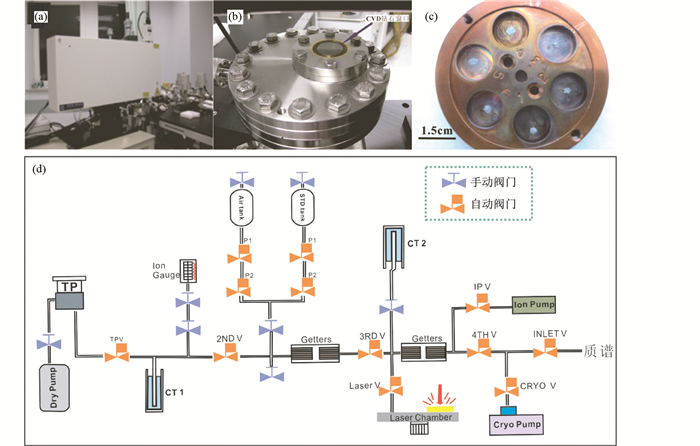
|
图 1 激光微区稀有气体的实验装置 (a) CO2激光器;(b) CVD金刚石激光样品窗;(c)激光样品盘;(d)纯化系统管线图 Fig. 1 Experimental device of noble gas with laser microprobe (a) CO2 laser; (b) CVD diamond laser window; (c) sample holder; (d) purification system pipeline schematic diagram |
我们选取Millbillillie(图 2)作为标样来建立及验证激光熔样稀有气体测定方法,依据如下:(1)Millbillillie总质量约330kg,是角砾岩化的玄武岩质钙长辉长无球粒陨石,于1960年降落至西澳大利亚,主要由长石和辉石组成,并含有少量钛铁矿、陨硫铁、硅质相、铬铁矿和一些含钙磷酸盐等次要矿物(Yamaguchi et al., 1994),几十年来已进行了较为详细的综合性研究(包括采用不同的定年手段如Ar-Ar、Lu-Hf、Pb-Pb等来确定结晶时间,并探讨其宇宙射线暴露历史和碰撞受热等过程,表 1);(2)我们选做标样的Millbillillie为粉末样品(< 200目)由瑞士伯尔尼(Bern)大学稀有气体实验室提供,该实验室已积累大量实验数据可做对照。另外,前人采用81Kr-K方法测得的宇宙暴露年龄位于20.8~25.4Ma之间,落在22Ma峰值区间内(表 1, Willis et al., 1990; Miura et al., 1993, 1998; Eugster and Michel, 1995; Shukolyukov and Begemann, 1996; Strashnov et al., 2013);利用宇宙成因3He浓度和产率计算所得宇宙暴露年龄(t3)偏小,可能是由于长石矿物中3H或3He扩散丢失所致(Miura et al., 1998);(3)所测粉末样品成分均匀,代表陨石全岩性质,理论上测得稀有气体数据波动范围极小,可监控激光熔样分析时的系统状态和实验流程。
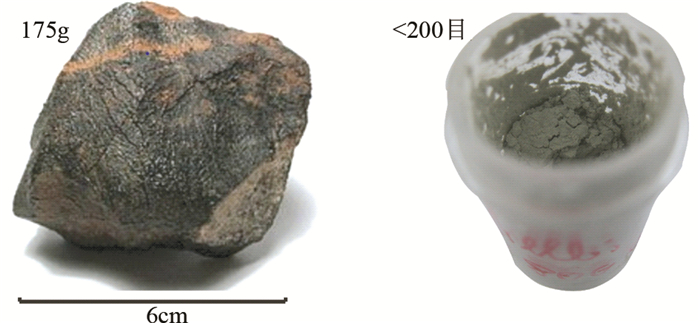
|
图 2 陨石标样Millbillillie碎块与粉末样 碎块图片引自http://en.wikipedia.org/wiki/Millbillillie_(meteorite) Fig. 2 Standard meteorite Millbillillie fragment and powder Fragment picture is from the website http://en.wikipedia.org/wiki/Millbillillie_(meteorite) |
|
|
表 1 Millbillillie宇宙暴露年龄和其它放射性同位素年龄(年龄单位:Ma) Table 1 Cosmic ray exposure ages and other radionuclide ages for Millbillillie |
在计算陨石样品宇宙暴露年龄时,需要用到样品质量(g)这一参数。激光熔样只需几毫克样品,为了准确称量其质量,并得到精确的称量误差,我们需要对梅特勒分析天平进行长期监测,以期获得样品称重与误差的关系。
本实验室所用分析天平分析精度为0.00001,最大称量误差10%。为核实天平最小可靠称量质量,选取11颗不同质量的橄榄石颗粒,先用去离子水在超声波中清洗3次,再用丙酮清洗1次,最后放入设定温度为60℃的烘箱中进行烘干。用100g砝码对天平进行质量校正,每隔3~5天进行一次内部校正,以保证天平称量精度。对每颗橄榄石颗粒称重1~3次/天,持续4个月,同时记录称量时间及结果。整个实验周期内,天平始终与电源连通,以使天平内部零部件保持稳定;若天平断电,再次通电后天平需静置至少1个小时,并重新进行质量校正。
每颗橄榄石重复称重约150次,取平均值为每颗橄榄石的实际重量M平均,标准偏差作为称量误差σ,Mmin-Mmax表示称量范围(表 2)。图 3表明,样品实际重量M平均与称量误差σ成幂指数关系,关系式为y=0.045x-0.95,R2=0.990。当x < 2.5mg时,随着x减小,y急剧增长;当x=2.5mg时,相对称量误差减小至0.75%;当x > 2.5mg时,随着x增大,y缓慢减小。因此质量越大,天平称重误差越小。根据激光熔样效率与样品实际情况,我们将待测陨石样品质量控制在2.5~10mg之间。
|
|
表 2 橄榄石颗粒重量与称量误差 Table 2 Olivine granule weight and weighing error |
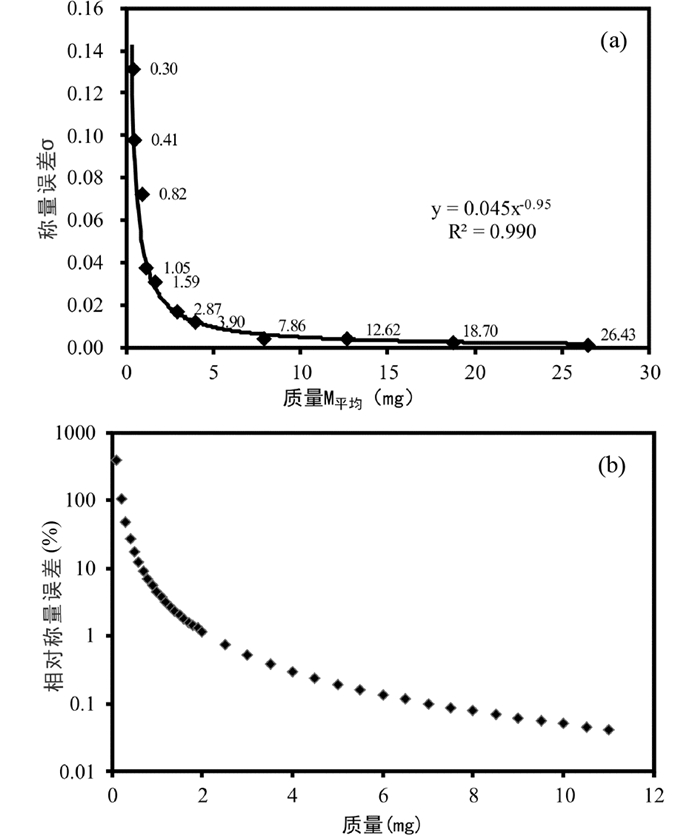
|
图 3 分析天平称量误差与质量关系(a)及相对称量误差与质量关系(b) Fig. 3 The relation between analytical balance weighing error and quality (a) and the relation between relative weighing error and quality (b) |
将已称重的Millbillilllie标样装入激光样品盘,纯化系统(包括样品盘)在90℃下被烘烤至少3天,以去除样品表面所吸附的大气稀有气体组分。
2.3 激光熔融采用CW(连续波)模式远红外光波(10.6μm)对4个Millbillilllie标样进行加热熔融,样品用量约3~7mg,加热时间15~20min,最大输出功率55%(15~16W)。熔融期间,为防止样品受高能激光束突然辐射而飞溅,应缓慢增加激光输出功率直至样品经低温(均匀)受热烧结在一起,然后提高输出功率至55%,最后维持此输出功率对样品持续加热。
每个样品均多次熔融(罗马数字为加热熔融次数),且加热前,测定系统冷本底(样品盘未加热时本底值,CB),加热后,选取远离样品处测定系统热本底(激光加热样品盘空白处本底值,HB)。多次条件实验表明:样品第二次加热所释放He、Ne、Ar(图 4、图 5、图 6)气量约为第一次加热释放气量1%(最低可至万分之一)以下,且前者位于后者测量误差之内,因此可认为样品第一次加热熔融15min已完全释放出所含稀有气体。
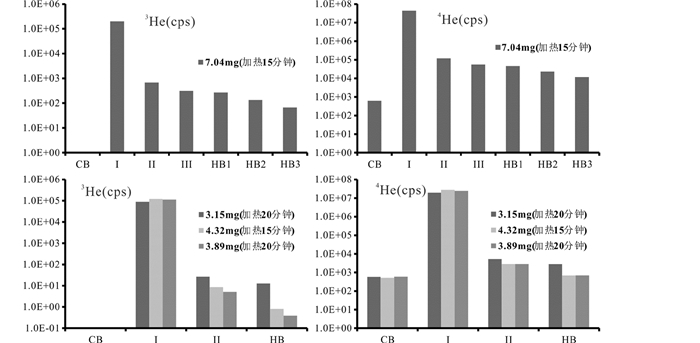
|
图 4 激光多次加热样品释放He气量 CB-冷本底;HB-热本底;罗马数字-加热次数; 图 5、图 6同 Fig. 4 He gas released by heating the sample several times with laser CB-cold background; HB-hot background; Roman numerals stand for heating times; also in Fig. 5 and Fig. 6 |
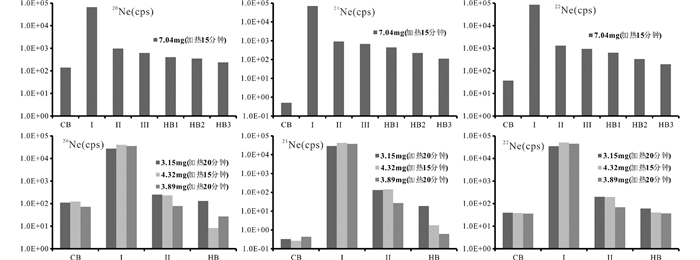
|
图 5 激光多次加热样品释放Ne气量 Fig. 5 Ne gas released by heating the sample several times with laser |
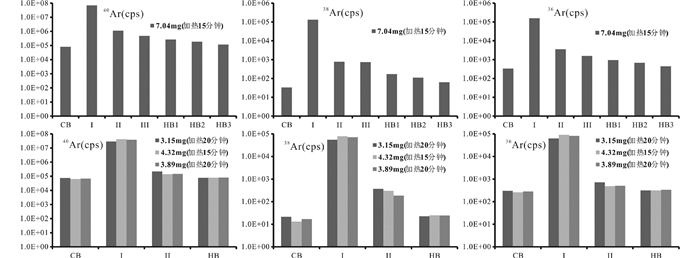
|
图 6 激光多次加热样品释放Ar气量 Fig. 6 Ar gas released by heating the sample several times with laser |
激光熔融样品后所释放的气体,先经两组锆-铝泵纯化,去除气体中所含H2O、CO2、CO、N2、H2及CH4等活性气体,避免多元素离子对质谱测量时造成干扰;接着用在液氮温度下工作并装有活性炭的冷阱CT2捕获管线中的Ar组分10min,使Ar与He、Ne分离。然后用35K低温工作的冷泵(CRYO)捕获管线的Ne组分10min,之后关闭冷泵阀门,达到He、Ne分离的目的。
管线内He气直接进入质谱仪最先进行测量;冷泵升温至80K,释放Ne 30min,之后打开冷泵阀门让Ne气进入质谱仪进行测量。Ne同位素被测量过程中离子源处冷阱保持液氮温度(降低40Ar++干扰),且冷泵与质谱处于联通状态,以进一步去除Ar同位素带来的干扰;最后加热缠绕在活性炭冷阱CT2外壁上的加热丝10min,释放并取部分Ar气进入质谱仪测量。
3 数据处理、校正及结果 3.1 系统本底如上所述,样品第一次加热熔融已基本释放出99%以上的稀有气体,残余样品、热本底与冷本底值均小于样品第一次加热熔融所测气量误差,残余样品气量与热本底值近似,且均略大于冷本底值(图 4-图 6)。因此,本文将残余样品值作为系统本底值对样品数据进行相应的本底扣除。
3.2 元素干扰本实验所用Noblesse稀有气体质谱仪分辨率>700,能够将3He+和HD+峰位完全分开,3He+的测量不受HD+分子离子的干扰,然而该分辨率无法将40Ar++和20Ne+,44CO2++和22Ne+完全分开,且38Ar与36Ar峰具烃类尾峰,因此要想准确测量20Ne+、22Ne+、38Ar和36Ar,必须对产生干扰的元素进行校正。
为减少44CO2++测量干扰,我们在质谱处增加一组Zr-Al泵吸附CO2,长时间实验数据表明系统CO2计数恒定,约为~2000计数/秒(cps即counts/s),因此扣除本底后,22Ne为真实值,已不受44CO2++干扰。对于40Ar++干扰,通过测定不同信号量Ne中40Ar++与40Ar+值,发现两者具线性相关,关系式40Ar++=0.1994 (40Ar+)-3.5182, R2=0.996。因此,可根据样品中40Ar+算得40Ar++含量,然后与双峰叠加处20Ne+相减,即可求得20Ne真实值。
38Ar与36Ar计数较小时,显示出明显的Ar及烃类双峰叠加现象,将双峰叠加值与烃峰值相减即可矫正烃峰干扰。
3.3 体积标定计算陨石宇宙暴露年龄需准确测定样品中稀有气体同位素含量,为此,需标定系统相应部分体积。我们采用He标样反扩散法来进行标定,方法如下(参见图 1d):
已知质谱体积为1800cc,一定量He标样气体扩散至质谱仪,磁场扫描获得4He信号值,记为Sms(Signalms简写,下同);打开质谱进气阀INLET V,将He标样气体逐步反扩散至系统管线或组件内,管线或组件体积记为V,扩散平衡后记下磁场扫描4He信号值,记为SV;根据理想气体状态方程PV=nRT,得Sms/SV=(V+Vms)/Vms,即V=(Sms-Sv)*Vms/Sv,依次类推,可获得系统各部分管线体积;不同气量He标样多次进气后,求得本实验室系统各部分管线体积平均值,即为最终标定的体积(表 3)。
|
|
表 3 系统各组件体积 Table 3 System component volume |
由于同位素质量差异和不同的接收器等因素,所测稀有气体同位素比值与真实值之间存在差异,我们采用仪器质量歧视参数Md来描述此差异,即Md=同位素比测量值/同位素比真实值。稀有气体质谱测定同位素气量单位为伏特(V,接收器为法拉第杯)或计数/秒(cps,接收器为电子倍增器),需换算成标准温度压力下气体的体积(单位:ccSTP),因此,在进行标准单位转换时,需先获得各同位素质谱灵敏度值。通过空气与He标样HESJ(20.63±0.10Ra)(Matsuda et al., 2002),我们获得本实验室He、Ne及Ar同位素质量歧视参数值(表 4)及质谱灵敏度值(表 5)。
|
|
表 4 仪器质量歧视参数 Table 4 Instrument quality discrimination parameters |
|
|
表 5 质谱灵敏度 Table 5 Mass spectral sensitivity |
结合上述体积标定值、质量歧视参数和各元素灵敏度值,我们对本实验室(IGGCAS) 4次激光熔融实验所获得的Millbillillie标样数据进行本底和元素干扰等矫正后,计算出样品稀有气体浓度及同位素比值,并与伯尔尼大学(Bern University)稀有气体实验室获得的Millbillillie标样数据同时列入表中(表 6)。
|
|
表 6 He、Ne、Ar同位素测量数据(浓度单位:10-8ccSTP/g) Table 6 He, Ne, Ar isotope measurement data (concentration unit: 10-8ccSTP/g) |
这里,我们根据宇宙射线成因3He、21Ne和38Ar浓度及产率计算相应核素宇宙暴露年龄(表 7)。表 7同时列出伯尔尼大学稀有气体实验室Millbillillie陨石标样数据。宇宙射线成因稀有气体同位素浓度计算参考Eugster et al. (2007)发表的文章,相应核素产率模型采用Eugster and Michel (1995)推导出的HEDs陨石宇宙成因稀有气体核素产率模型。
|
|
表 7 宇宙成因3He、21Ne、38Ar浓度、产率及宇宙暴露年龄(浓度单位:10-8ccSTP/g,产率单位:10-8ccSTP/(g×Ma),年龄单位:Ma) Table 7 Cosmogenetic 3He, 21Ne, 38Ar concentrations, yields and cosmic exposure age (concentration unit: 10-8ccSTP/g; yield unit: 10-8ccSTP/(g×Ma); age unit: Ma) |
本实验室4个Millbillille样品的3He、4He、20Ne、21Ne、22Ne、36Ar、38Ar和40Ar同位素含量平均值(1σ,单位是×10-8ccSTP)分别是:21.68±0.25、3256.71±34.67、4.04±0.14、4.16±0.14、4.93±0.17、3.91±0.15、3.39±0.11、1670.50±56.37;其中宇宙射线成因3He、21Ne、38Ar浓度值的测试精度分别为2.6%、2.1%和1.6%。本实验室激光熔样21Ne浓度的测试精度和传统高温炉提取法测试精度6.1%相比,提高约3倍。
下面主要通过对比本实验室激光熔样数据与Bern大学稀有气体实验室传统高温炉法所得Millbillillie数据来检验新建激光熔样的测试流程。
4.1 同位素浓度及比值对比He同位素 图 7中,无论是3He、4He测量浓度或4He/3He比值,在误差范围内,本实验室与Bern大学稀有气体实验室采用高温炉全岩熔融法的测量值均一致,表明激光熔样法可精确测定微量陨石He同位素浓度及比值。

|
图 7 He同位素测量值对比 Fig. 7 Comparison of He isotope measurements |
Ne同位素 与Bern大学稀有气体实验室测量值相比,本实验室所测21Ne与22Ne浓度略低,但在误差范围内相一致,而Bern大学所测20Ne浓度却明显偏高(图 8)。分析原因,有可能是Bern大学稀有气体实验室未精确扣除40Ar++干扰而导致测得20Ne值偏大;也可能是该样品在Bern大学稀有气体实验室烘烤不足,导致部分吸附的大气组分未完全去除所致。Bern大学稀有气体实验室样品烘烤温度为80℃(Leya et al., 2013),而本实验室烘烤温度为90℃,因而在理论上,本实验室更易去除样品所吸附大气组分干扰。另一方面,本实验所测Ne同位素完全落在宇宙成因Ne区域内(图 8),而Bern大学稀有气体实验室所测数据明显偏离宇宙成因Ne区域,极有可能是受大气组分干扰所致。
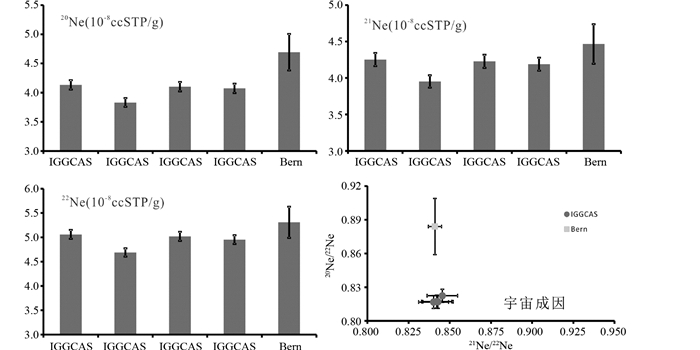
|
图 8 Ne同位素测量值对比 Fig. 8 Comparison of Ne isotope measurements |
Ar同位素 比较Ar同位素测量值发现伯尔尼大学稀有气体实验室所测36Ar、38Ar与40Ar均比本实验室所测值偏大(图 9)。与上文所述Ne同位素类似,这也可能是由于该样品烘烤不足导致部分大气组分Ar未完全去除所致。同时,本实验室所测Ar同位素更靠近宇宙成因端源,而伯尔尼大学稀有气体实验室所测Ar同位素却更靠近大气端源(图 9),这也证实了传统高温炉法受大气组分Ar的影响。
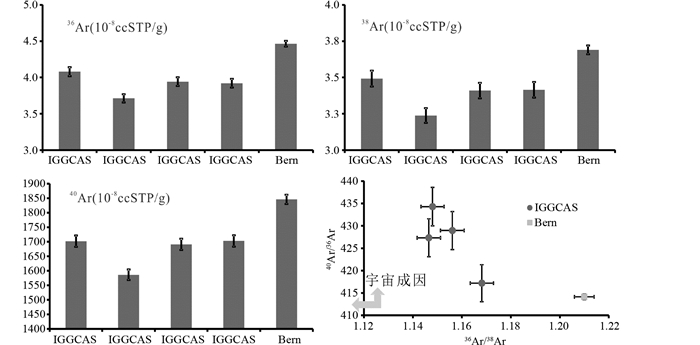
|
图 9 Ar同位素测量值对比 Fig. 9 Comparison of Ar isotope measurements |
利用本实验室新建立的激光熔融法所测稀有气体数据,计算标样陨石Millbillillie宇宙暴露年龄t3、t21和t38平均年龄分别为13.43±1.39Ma、22.59±2.31Ma和19.79±3.97Ma,与Bern大学稀有气体实验室采用高温炉全岩熔融法测得的年龄12.91±1.34Ma、24.05±2.81Ma和21.28±4.26Ma相一致(表 7、图 10),且与前人所测年龄(包括81Kr-Kr年龄)误差内亦一致(表 1)。

|
图 10 宇宙暴露年龄对比 Fig. 10 Cosmic Exposure Age Comparison |
综上所述,本实验室新建立的稀有气体激光熔融法能够准确测得微量陨石样品中稀有气体含量及同位素比值,根据稀有气体数据所计算出的陨石宇宙暴露年龄是准确且可靠的。
4.3 本底值及相对标准偏差RSD%对比本实验室所建微量陨石激光熔样稀有气体测定方法典型本底值见表 8,除了21Ne和22Ne,均明显低于Bern大学稀有气体实验室高温炉法测定系统本底值。表明与传统高温炉全岩熔融法相比,激光熔样稀有气体测定方法具本底低、样品用量少的优势。
|
|
表 8 本底值(单位:10-12ccSTP)和相对标准偏差(RSD%) Table 8 Base value (unit: 10-12ccSTP) and relative standard deviation (RSD%) |
根据本次陨石标样Millbillillie测量值,我们计算出各同位素浓度及比值相对标准偏差(表 9),其中同位素浓度和比值的RSD%分别为1%~4%和 < 2%,完全能够满足陨石稀有气体测定需求。
|
|
表 9 陨石标样测量平均值相对标准偏差(RSD%) Table 9 Mean relative standard deviation (RSD%) for Meteorite standard measurement |
(1) 中国科学院地质与地球物理稀有气体实验室已初步建立起微量陨石激光熔样稀有气体测定方法,利用本方法能够准确测得微量陨石样品中稀有气体含量及同位素比值。根据稀有气体数据所计算出的陨石宇宙暴露年龄准确可靠。
(2) 与传统高温炉全岩熔融法所测数据相比,激光熔样稀有气体测定方法所测的Millbillillie标样20Ne及Ar同位素浓度略低,更靠近宇宙成因端源,不易受大气组分的干扰,且21Ne测试精度由6.1%提高至2.1%。
(3) 微量陨石激光熔样稀有气体测定方法仪器平均本底值低,测得的稀有气体同位素浓度及比值精度分别为1%~4%和 < 2%,能满足陨石稀有气体的测定需求。
致谢 Millbillillie标样陨石样品由瑞士伯尼尔(Bern)大学稀有气体实验室Ingo Leya教授提供,在此表示感谢!
Aoudjehane HC, Avice G, Barrat JA, Boudouma O, Chen G, Duke MJM, Franchi IA, Gattacceca J, Grady MM, Greenwood RC, Herd CDK, Hewins R, Jambon A, Marty B, Rochette P, Smith CL, Sautter V, Verchovsky A, Weber P and Zanda B. 2012. Tissint martian meteorite:A fresh look at the interior, surface, and atmosphere of Mars. Science, 338(6108): 785-788. DOI:10.1126/science.1224514 |
Bast R, Scherer EE, Taetz S, Sprung P, Mezger K and Srinivasan G. 2012. Internal Lu-Hf isotope systematics of the Eucrites Millbillillie and Piplia Kalan. In: Proceedings of the 43rd Lunar and Planetary Science Conference. Texas, 2542
|
Bizzarro M, Baker JA, Haack H and Lundgaard KL. 2005. Rapid timescales for accretion and melting of differentiated planetesimals inferred from 26Al-26Mg chronometry. The Astrophysical Journal Letters, 632(1): L41-L44. DOI:10.1086/497638 |
Bouvier A, Blichert-Toft J, Vervoort JD and Albarède F. 2006. Effects of impacts on Sm-Nd and Lu-Hf internal isochrons of eucrites. Meteoritics & Planetary Science, 41(Suppl.1): 5348. |
Das JP, Goswami JN, Pravdivtseva OV, Meshik AP and Hohenberg CM. 2012. Cosmogenic neon in grains separated from individual chondrules:Evidence of precompaction exposure in chondrules. Meteoritics & Planetary Science, 47(11): 1869-1883. |
Das JP, Baldwin SL and Delano JW. 2016. 40Ar/39Ar and cosmic ray exposure ages of plagioclase-rich lithic fragments from Apollo 17 regolith, 78461. Earth, Planets and Space, 68: 11. DOI:10.1186/s40623-016-0381-9 |
Eugster O and Michel T. 1995. Common asteroid break-up events of eucrites, diogenites, and howardites and cosmic-ray production rates for noble gases in achondrites. Geochimica et Cosmochimica Acta, 59(1): 177-199. DOI:10.1016/0016-7037(94)00327-I |
Eugster O. 2003. Cosmic-ray exposure ages of meteorites and lunar rocks and their significance. Chemie der Erde-Geochemistry, 63(1): 3-30. DOI:10.1078/0009-2819-00021 |
Eugster O and Lorenzetti S. 2005. Cosmic-ray exposure ages of four acapulcoites and two differentiated achondrites and evidence for a two-layer structure of the acapulcoite/lodranite parent asteroid. Geochimica et cosmochimica acta, 69(10): 2675-2685. DOI:10.1016/j.gca.2004.12.006 |
Eugster O, Herzog GF, Marti K and Caffee MW. 2006. Irradiation records, cosmic-ray exposure ages, and transfer times of meteorites. In: Lauretta DS and McSween HY Jr (eds.). Meteorites and the Early Solar System Ⅱ. Tucson: University of Arizona Press, 829-851
|
Eugster O, Lorenzetti S, Krähenbühl U and Marti K. 2007. Comparison of cosmic ray exposure ages and trapped noble gases in chondrule and matrix samples of ordinary, enstatite, and carbonaceous chondrites. Meteoritics & Planetary Science, 42(7-8): 1351-1371. |
Hopkins MD and Mojzsis SJ. 2012. Early thermal events in the HED Parent Body (4 Vesta) recorded in zircon U-Th-Pb depth profiles from Millbillillie brecciated eucrite. In: Workshop on the Early Solar System Bombardment Ⅱ. Houston, Texas, 30-31
|
Kennedy T, Jourdan F, Bevan AWR, Gee MAM and Frew A. 2013. Impact history of the HED parent body(ies) clarified by new 40Ar/39Ar analyses of four HED meteorites and one anomalous basaltic achondrite. Geochimica et Cosmochimica Acta, 115: 162-182. DOI:10.1016/j.gca.2013.03.040 |
Leya I, Ammon K, Cosarinsky M, Dalcher N, Gnos E, Hofmann B and Huber L. 2013. Light noble gases in 12 meteorites from the Omani desert, Australia, Mauritania, Canada, and Sweden. Meteoritics & Planetary Science, 48(8): 1401-1414. |
Mahajan RR and Murty SVS. 2003. Laser microprobe for the study of noble gases and nitrogen in single grains:A case study of individual chondrules from the Dhajala meteorite. Journal of Earth System Science, 112(1): 113-127. DOI:10.1007/BF02710047 |
Marty B, Kelley S and Turner G. 2010. Chronology and shock history of the Bencubbin meteorite:A nitrogen, noble gas, and Ar-Ar investigation of silicates, metal and fluid inclusions. Geochimica et Cosmochimica Acta, 74(22): 6636-6653. DOI:10.1016/j.gca.2010.05.035 |
Matsuda J, Matsumoto T, Sumino H, Nagao K, Yamamoto J, Miura Y, Kaneoka I, Takahata N and Sano Y. 2002. The 3He/4He ratio of the new internal He Standard of Japan (HESJ). Geochemical Journal, 36(2): 191-195. DOI:10.2343/geochemj.36.191 |
Michel T and Eugster O. 1989. Cosmic-ray exposure ages of howardites, eucrites, and diogenites. Meteoritics, 24: 304. |
Miura Y, Sugiura N and Nagao K. 1993. 81Kr-Kr exposure ages and noble gas isotopic compositions of three non-Antarctic eucrites Millbillillie, Camel Donga and Juvinas. In: Proceedings of the 18th Symposium on Antarctic Meteorites. Tokyo, 182-185
|
Miura YN, Nagao K, Sugiura N, Fujitani T and Warren P. 1998. Noble gases, 81 Kr-Kr exposure ages and 244 Pu-Xe ages of six eucrites, Béréba, Binda, Camel Donga, Juvinas, Millbillillie, and Stannern. Geochimica et Cosmochimica Acta, 62(13): 2369-2387. DOI:10.1016/S0016-7037(98)00118-5 |
Nagao K, Okazaki R, Nakamura T, Miura YN, Osawa T, Bajo KI, Matsuda S, Ebihara M, Ireland TR, Kitajima F, Naraoka H, Noguchi T, Tsuchiyama A, Yurimoto H, Zolensky ME, Uesugi M, Shirai K, Abe M, Yada T, Ishibashi Y, Fujimura A, Mukai T, Ueno M, Okada T, Yoshikawa M and Kawaguchi J. 2011. Irradiation history of Itokawa regolith material deduced from noble gases in the Hayabusa samples. Science, 333(6046): 1128-1131. DOI:10.1126/science.1207785 |
Nakamura T, Nagao K and Takaoka N. 1999. Microdistribution of primordial noble gases in CM chondrites determined by in situ laser microprobe analysis:Decipherment of nebular processes. Geochimica et Cosmochimica Acta, 63: 241-55. DOI:10.1016/S0016-7037(98)00275-0 |
Okazaki R and Nagao K. 2017. Primordial and cosmogenic noble gases in the Sutter's Mill CM chondrite. Meteoritics & Planetary Science, 52: 669-89. |
Polnau E, Eugster O, Krahenbuhl U and Marti K. 1999. Evidence for a precompaction exposure to cosmic rays in a chondrule from the H6 chondrite ALH76008. Geochimica et cosmochimica acta, 63(6): 925-933. DOI:10.1016/S0016-7037(98)00316-0 |
Ranjith PM, He HY, Miao BK, Su F, Zhang CT, Xia ZP, Xie LF and Zhu RX. 2017. Petrographic shock indicators and noble gas signatures in a H and an L chondrite from Antarctica, Planetary and Space Science, 146: 20-29
|
Riebe MEI, Huber L, Metzler K, Busemann H, Luginbuehl SM, Meier MM, Maden C and Wieler R. 2017. Cosmogenic He and Ne in chondrules from clastic matrix and a lithic clast of Murchison:No pre-irradiation by the early sun. Geochimica et Cosmochimica Acta, 213: 618-634. DOI:10.1016/j.gca.2017.06.035 |
Roth ASG, Baur H, Heber VS, Reusser E and Wieler R. 2011. Cosmogenic helium and neon in individual chondrules from Allende and Murchison:Implications for the precompaction exposure history of chondrules. Meteoritics & Planetary Science, 46(7): 989-1006. |
Roth ASG, Trappitsch R, Metzler K, Hofmann BA and Leya I. 2017. Neon produced by solar cosmic rays in ordinary chondrites. Meteoritics & Planetary Science, 52(6): 1155-1172. |
Schiller M, Baker JA and Bizzarro M. 2010. 26Al-26Mg dating of asteroidal magmatism in the young Solar System. Geochimica et Cosmochimica Acta, 74(16): 4844-4864. DOI:10.1016/j.gca.2010.05.011 |
Shukolyukov A and Begemann F. 1996. Cosmogenic and fissiogenic noble gases and 81Kr-Kr exposure age clusters of eucrites. Meteoritics & Planetary Science, 31(1): 60-72. |
Shukolyukov YA, Nazarov MA and Korochantseva EV. 2007. Cosmic ray exposure age and time of formation of a new meteorite, Dhofar 007 achondrite from Oman:A rock fragment from the asteroid Vesta. Petrology, 15(1): 1-18. DOI:10.1134/S0869591107010018 |
Strashnov I, Bland PA, Spurny P, Towner MC and Gilmour JD. 2013. Times of impacts that deliver samples of Vesta to Earth derived from ultrasensitive 81 Kr-Kr cosmic ray exposure age analysis of Eucrites. Geochimica et Cosmochimica Acta, 106: 71-83. DOI:10.1016/j.gca.2012.11.043 |
Vogel N, Baur H, Bischoff A and Wieler R. 2011. Cosmic ray exposure ages of Rumuruti chondrites from North Africa. Chemie der Erde-Geochemistry, 71(2): 135-142. DOI:10.1016/j.chemer.2011.02.008 |
Wang DD and Wang RT. 1999. Noble gas and cosmic-ray exposure age of Juancheng chondrite. Chinese Science Bulletin, 44(12): 1142-1143. DOI:10.1007/BF02886145 |
Wang DD, Lin YT and Liu JY. 2001. Cosmic-ray exposure and gas retention ages of the Guangmingshan (H5) chondrite. Chinese Science Bulletin, 46(18): 1544-1546. DOI:10.1007/BF02900577 |
Willis RD, Thonnard N, Eugster O, Michel T and Lehmann BE. 1990. The cosmic ray exposure age of the Millbillillie meteorite determined by conventional mass spectrometry and by RIS-TOF. Resonance Ionization Spectroscopy, 19902: 275-278. |
Yamaguchi A, Takeda H, Bogard DD and Garrison D. 1994. Textural variations and impact history of the Millbillillie eucrite. Meteoritics, 29(2): 237-245. DOI:10.1111/maps.1994.29.issue-2 |
 2018, Vol. 34
2018, Vol. 34

